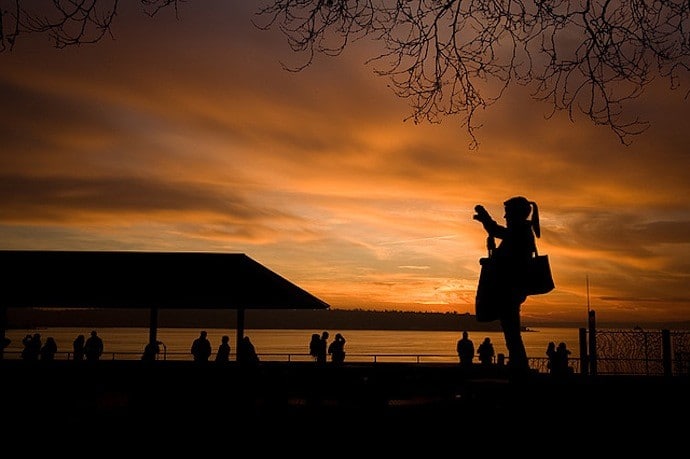 This is a guest post by Darin Rogers, a freelance photographer and writer who specializes in culture, travel, and architecture – with a bit of everything else thrown in for good measure. Darin sent me his latest ebook, Capturing The Journey, a wonderful primer to making your travel photos better using the techniques that are second nature to photographers and shares some sunset specifics with us today. All of the photos in this post were taken by Darin.
This is a guest post by Darin Rogers, a freelance photographer and writer who specializes in culture, travel, and architecture – with a bit of everything else thrown in for good measure. Darin sent me his latest ebook, Capturing The Journey, a wonderful primer to making your travel photos better using the techniques that are second nature to photographers and shares some sunset specifics with us today. All of the photos in this post were taken by Darin.
Sunsets are one of the most photographed subjects on the planet. And for good reason. They are pretty, often made up of colors not commonly seen otherwise on a daily basis in the natural world. But because they are so photographed, sunsets have become a bit of a photographic cliche. Although every sunset is unique, it can be a real challenge to capture them in a unique way.
It’s difficult to completely escape the cliched aspect of sunset images, but here are 5 things you can do to improve your odds of capturing something interesting.
1. Look Behind You
We tend to go through life moving forward. Biologically, much of this comes from our physical makeup with our feet pointed forward and eyes in front of our heads. We don’t spend a lot of time looking behind us (or above us), unless of course we’re being chased. Sometimes, however, the best things really are behind you. And this can be true of sunsets. The sun may be setting in front of you but maybe it’s those clouds behind you where all the visual action is happening, or, importantly, where there just might be a more interesting composition.
2. Make Use Of Leading Lines
Not familiar with the concept of leading lines? Well, they are elements within your image that are used to compose and draw your viewer into the image. Notice in the first example below how I’ve used the line of the boardwalk, and to an extent the rocks on the left side, to give your eye a ‘path’ to follow into the image. This is a classic way to engage the viewer.

In the second example, see how the lines of the beach ultimately draw you to the fisherman and boat in the distance?

Monkey Mia, Western Australia (Technically this is a sunrise, but the concepts are the same.)
3. Look For The Story
A pretty picture is, well, just a pretty picture. Instead of simply a static image, what kind of story can you tell? Is there something going on around you that you can incorporate into the image to provide some interest for your viewers, make them think or ask questions? This is possibly the most important tip I can give. Again, it’s about engaging your viewers.

Subic Bay, Philippines
4. Look For Silhouettes
Sunsets are great times to look for and make use of silhouettes. Silhouettes often come about naturally when including objects in sunset photos, but if you keep your eye and mind open, you never know what less obvious idea you might come up with. Many things can make great silhouettes, especially if they are recognizable or create interesting patterns. Trees are often good subjects for silhouettes, particularly in winter when all the leaves are gone.

Elliot Bay from Victor Steinbrueck Park, Seattle, USA

Lone mangrove, Puerto Galera, Philippines
5. Place Something In The Foreground
You may be witnessing the most brilliant sunset in the world but if all you’re showing in your photo is the sunset, your image is likely going to feel rather static, like something is missing. Try placing something in the foreground. Foreground elements can add additional interest to a composition. Sunsets are rather distant subjects so placing something in the foreground can help to balance the composition as well.

Grass and sand dunes, Newport, Oregon, USA
In the end, it’s possible to move beyond the cliche and get a good sunset photo. Remember, a good sunset photo isn’t necessarily about the sunset, but rather, how well you engage the people viewing it.
Darin, thank you for the guest post. Darin Rogers is a freelance photographer specializing in culture, travel, and architecture. Originally from the States, he currently bases himself in Australia and the Philippines. He regularly travels the world, searching for awesome shots that will contribute to his becoming world famous. You can see more of his work in a copy of his ebook, Capturing The Journey and read his blog at http://www.darinrogers.net/. Darin can also be found on Facebook and Google+.












As you know, I’m always on the lookout for ANY tips that will help produce a better photo. I’ve probably taken thousands of sunset photos in my time and the vast majority, I’ve deleted. Quite proud of myself for realising quite early on though that a winter tree makes a good silhouette. 😉
Julia
Or an Autumn one too 🙂 I like this latest one you took:
The lesser the light, the more difficult it is to take pictures. These tips are really good, esp the “look behind” thing. 😀
One of my favorites in any light. Something the best shots are just behind you 🙂
Fantastic tips there. I love to snap photos of sunsets but often forget to take some time and compose myself first. There’s a few lessons in here I’ll be keeping in mind for future reference.
Thanks for sharing!
It’s such a short window of time maybe there’s a bit of the feeling of being rushed.
Thanks, that is some good advice. For some reason I haven’t really done much silhouettes against sunsets, how could I have forgotten that. Need to experiment. Love the Lone mangrove photo, so simple.
When I first read Darin’s post I thought the exact same thing 🙂
Where are your shots Anil?!!!
haha, I need to dig up some sunset photos, I actually don’t have too many! Here’s as close as I’ve gotten recently in Cairo:
I was hoping to see your sunset pics of Alhambra since I visited a couple of weeks ago!
Coming very soon, I still haven’t been able to get around to processing the photos yet! How did you enjoy Granada?
It was great, not just because of Alhambra, but also Albayzín & Sacromonte.
I’m tempted to say that I enjoyed Granada even more than Seville or Madrid!
I’m surprised to hear that – many people I’ve met in the last few weeks prefer Seville! I haven’t been so can’t compare yet but loved what I saw in Granada 🙂
I’m inspired! I’m always shooting sunsets willy-nilly because I just want to remember the beauty of it – now I know why it never worked! 🙂 Thanks so much! -Veronica
Nature makes it so easy sometimes doesn’t it? Glad this post helped inspire your wanderlust!
Pretty useful blog for ‘wannabe’ photographers like me. I use cheat sheet before a trip, I end up taking photo’s on ‘auto-mode’on the trip.:D